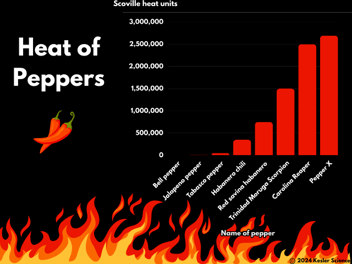What to Do with Too Much Carbon - Kesler Science Weekly Phenomenon and Graph
Whether it's hitting the golf course, taking a wintertime ski trip, or hiking with my family, I like to enjoy the great outdoors when I can.🌲There's something special about seeing nature's delicate balance between different factors to keep life going.
Of course, hearing about how excess carbon can negatively impact arctic and ocean ecosystems has been a total downer. That's why I was so happy to dig up ambitious solutions scientists are seriously looking at to reduce carbon dioxide levels.
We've all heard about the importance reforestation and renewable energy, but here are some lesser-known ways we're looking at to troubleshoot too much carbon:
🌳Nature-based solutions: When looking for ways to cut down carbon dioxide in the atmosphere, sometimes it helps to just let nature do its thing. We usually think of land plants as being a huge carbon sink, but the ocean also plays a really big role in balancing out global CO2.
Marine kelp (AKA "seaweed") is one of the most efficient carbon-storing organisms out there. Giant kelp can grow at an astonishing rate of almost 2 feet a day. 😱 That's a lot of carbon being pulled out of the air and ocean water.
Seaweed farming is turning into an exciting new market of agriculture. There are hardly any inputs needed to grow kelp and the plant naturally absorbs the phosphorous and nitrogen that lead to those nasty algal blooms. Seaweed is also totally edible, so keep your eyes open for kelp dishes at your favorite restaurant in the near future!
💨 Direct air capture: It might sound like a lot of work to filter extra CO2 out of the atmosphere, but scientists are developing devices that pretty much run on their own! Direct air capture (DAC) is a broad approach of using technology to physically separate greenhouse gases.
The University of Cambridge just revealed a device that uses solar energy to pull carbon dioxide out of the air and convert it into a resource called "syngas." Syngas can be applied as a gasoline substitute, a fertilizer, or used to make plastics - how cool would it be to replace fossil fuels with carbon direct from our atmosphere?!
Another creative DAC idea is using "mechanical trees," like the one designed by Arizona State University. I get it - making a tree out of metal seems silly, but keep in mind that a typical tree can take 48 pounds of CO2 out of the air in a year. ASU's mechanical tree can take 187 pounds of CO2 out of the air in a day!
⛏️ Carbon mineralization: Let's say we've yanked a whole bunch of carbon dioxide gas out of the atmosphere. Now what do we do with it? Making fuel like syngas is one option, but engineers are also looking to pump the gas back into Earth's crust!
There's a ridiculous amount of carbon stored in the rocks of our planet's surface. That's why gravel and cement production is such a huge contributor to greenhouse gases - the carbon dioxide that was locked away is released once we break the rocks apart.
Carbon mineralization is a natural process where CO2 in the air reacts with exposed rocks or ocean water to form a solid called carbonate. This has been an important way for Earth to regulate carbon, as it tucks the greenhouse gas away for a really long time.
Industries can replicate this process by letting carbon dioxide interact with reactive rocks, like basalt, and turning the gas into solid to remove it from the atmosphere. More intense approaches include injecting the gas deep underground, like in old mining areas, in order to make it react with the rocks down below.
It's interesting to know that carbon is not stored in the same way across different ecosystems. Check out the graph below, showing how much carbon dioxide plant matter and soil hold on to in various terrestrial settings. The graph measures tons of carbon stored per hectare of area. A hectare is 10,000 square meters.
If I brought this graph into the classroom, here are some questions I'd have to go with it:
💡According to the graph, is there more carbon stored in plant matter or in the soil? In which ecosystem is there about the same amount of carbon stored in the plants and soil? The graph shows that there is more carbon stored in the soil compared to the plants. Tropical forests have about the same amount of carbon stored above and below ground, with 120 tons stored in plants and 123 tons stored in the soil.
💡A county in your state would like to reduce how much carbon dioxide is released into the atmosphere. Which ecosystem would you recommend the county try to preserve? Why do you say so? The graph shows that wetlands are most effective overall at storing carbon. Wetlands store 43 tons of carbon above ground and 643 tons of carbon in the soil, which is the largest carbon "sink" shown on the graph.
💡If a temperate forest is converted to a cropland, how would the amount of carbon that could be stored be impacted? A temperate forest can store 57 tons of carbon per hectare above ground, while cropland can only store 2 tons of carbon per hectare. Temperate forests store 96 tons of carbon per hectare in the soil while cropland stores 80 tons of carbon per hectare. Overall, cropland stores 71 tons of carbon per hectare less than a temperate forest.



